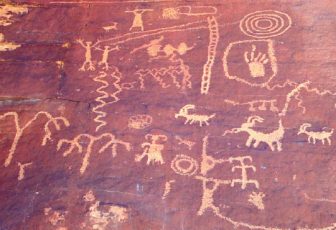Petroglyphs are a subset of the general category of rock art or rock graphics, which also includes pictographs and geoglyphs. Petroglyphs (petro-rock, glyph-carving) are man-made images or a series of geometric patterns that are carved, pecked, chipped, or abraded into stone using crude hand-held implements such as rocks, bones, antlers, and a wide variety of other objects as a chisel. Pictographs are created by painting on a rock using pigment materials such as charcoal, ash, lime, iron oxides, and ocher. The minerals were ground into fine powders and mixed with a variety of locally available substances such as animal blood, resins, fats from animals, or seed to form a binder. Evidence of pictographs in open areas has disappeared due to weathering and erosion, but some have survived in protected areas such as caves, overhanging cliffs, and shelters. Geoglyphs are large surface images made by arranging rock debris or scraping away the surface area to reveal the underlying subsoil or rock surface to form the outlines of animals and human-like figures.
 Found all around the world on a wide variety of surfaces from the desert varnish of basalts of the American Southwest to the glacier polished sandstones of the Alps, the common method of chipping on petroglyphs is to remove the outer weathered patina of the rock to reveal the usually lighter colored surface beneath. Rock that is very hard or contains an abundance of quartz is less suitable than softer limestones and other sedimentary rocks.
Found all around the world on a wide variety of surfaces from the desert varnish of basalts of the American Southwest to the glacier polished sandstones of the Alps, the common method of chipping on petroglyphs is to remove the outer weathered patina of the rock to reveal the usually lighter colored surface beneath. Rock that is very hard or contains an abundance of quartz is less suitable than softer limestones and other sedimentary rocks.
The images created on the petroglyphs vary from abstract combinations of straight, parallel, and wavy lines, crosshatches, diamonds, circles, dots, and zigzags, to anthropomorphs displaying human representations of stick figures and others with elaborately outfitted clothing and headdresses. Other graphics are zoomorphs, or animal figures. Like anthropomorphs, they vary from simple stick figures to complex scenes, and stylized figures with much detail. They differ depending on the location and animal life peculiar to the local environment, and from continent to continent.
Unlike hieroglyphics, petroglyphs are generally not a language but are images that record events, serve as historical markers, depict people and their tools and weapons, label geological formations such as springs, represent spiritual being and other mythical or magical beliefs, or serve some ritualistic purpose. Interpretation of many are yet to be categorized and their meanings to be determined.
Petroglyph sites provide a method of dating by a process of association with artifacts found in the surrounding area, for example, artifacts in campsites, villages, and hunting and food processing areas. On the petroglyph itself, dating can be accomplished by identification of the subjects, weapons, tools, style analysis, and any other objects depicted.
Petroglyphs are found worldwide with images peculiar to each region. Major concentrations appear on all the continents, but in particular in the American Southwest, Hawaii, Easter Island, South Africa, Middle and South America, England and Scotland, Europe in the Alps, France and Italy, and in Asia (China and Pakistan).
From early times to the present, petroglyphs present evidence that human beings utilized their surroundings to draw symbols and pictures to express their need to communicate ideas to their fellow man.
References:
- Arnold, C. (1996). Stories in stone: Rock art pictures of early Americans. Boston, MA: Clarion Books.
- Moore, S. (1999). Petroglyphs: Ancient language/sacred art. Santa Fe, NM: Clearer Light.
- Whitley, D. S. (Ed.) (2001). Handbook of rock art research. New York: AltaMira Press.

